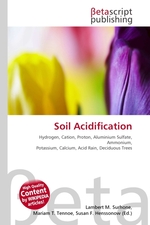Soil Acidification
Lambert M. Surhone, Miriam T. Timpledon, Susan F. Marseken
бумажная книга
High Quality Content by WIKIPEDIA articles! Soil acidification is the buildup of hydrogen cations, also called protons, reducing the soil pH. This happens when a proton donor is added to the soil. The donor can be an acid, such as nitric acid and sulfuric acid (these acids are common components of acid rain). It can also be a compound such as aluminium sulfate, which reacts in the soil to release protons. Many nitrogen compounds, which are added as fertilizer, also acidify soil over the long term because they produce the ammonium ion which is a proton donor. Acidification also occurs when base cations such as calcium, magnesium, potassium and sodium are lost from the soil. Losses occur when these bases are leached from the soil. This leaching increases with increasing precipitation. Acid rain accelerates the leaching of bases. Plants take bases from the soil as they grow, donating a proton in exchange for each base cation. Where plant material is removed, as when a forest is logged or crops are harvested, the bases they have taken up are permanently lost from the soil.
Данное издание не является оригинальным. Книга печатается по технологии принт-он-деманд после получения заказа.


